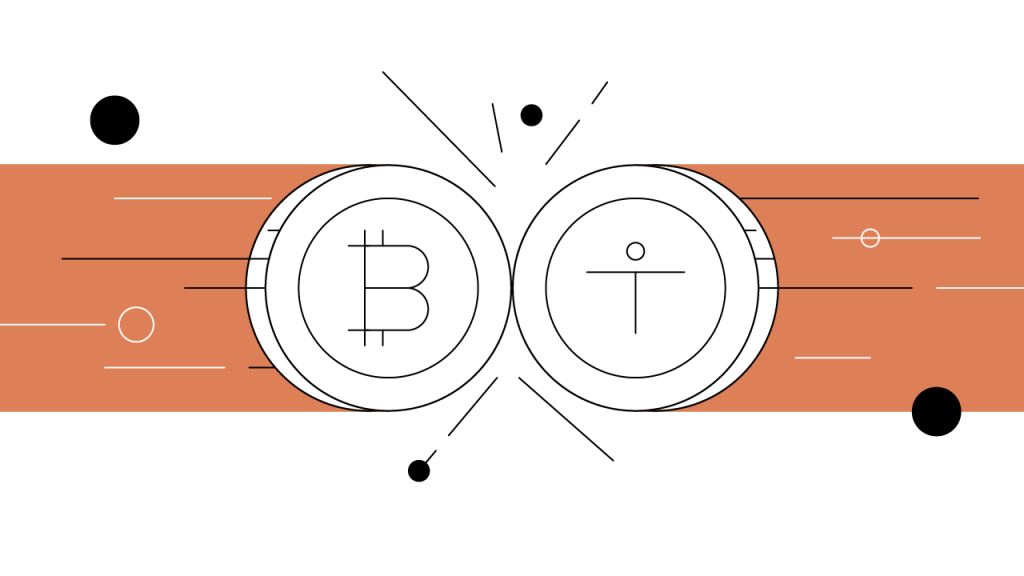Bitcoin on Ethereum: wBTC and tBTC
Lending the value and liquidity of Bitcoin to the extensibility of Ethereum and its smart contracts.
By
Updated November 2, 2023 • 3 min read

Summary
Currently, there are two main approaches to creating a bridge between Ethereum and Bitcoin: a centralized approach that relies on centralized custodians (wBTC) and a decentralized approach that uses a highly technical cryptographic process (tBTC). Tokenizing Bitcoin — that is, creating Bitcoin-backed assets by turning Bitcoin into an Ethereum-compliant ERC-20 token — via processes like wBTC and tBTC brings the value and liquidity of Bitcoin to Ethereum and expands the scope and strength of the DeFi ecosystem.
Collateral in DeFi
platforms on rely heavily on to make up for a lack of a universal identity protocol on Ethereum. At present, many DeFi platforms do not have the capability to capture credit scores, employment information, or savings data to mitigate the risk that a borrower will default on a loan. Instead, decentralized lending protocols require that users deposit collateral as a guarantee that loans will be paid back.
and , two popular DeFi platforms, both require collateral in order to create new loans. Both protocols require assets to be deposited before cryptocurrency can be borrowed. The more collateral that is locked up, the more you can borrow. If the value of your loan becomes too high relative to the value of your collateral, then your collateral is sold to pay back some or all of your loan. The amount that can be borrowed is therefore limited by the value of collateral in the system.
So far in the DeFi ecosystem, the most commonly collateralized asset has been , but bitcoin (BTC) offers a higher , more , and more collateral for DeFi projects.
Bridging BTC and Ethereum
The most recognized and highly capitalized digital asset in the world is , but the programmability of smart contracts on the Ethereum network drives much of the innovation in blockchain. By creating a Bitcoin-backed tokenized asset — that is, turning Bitcoin into an Ethereum-compliant — some of its industry-leading market value and liquidity may enter the Ethereum ecosystem, while simultaneously offering Bitcoin users an into the rapidly developing DeFi ecosystem. Ethereum wants to build a decentralized market where all cryptocurrencies can be traded, especially BTC, the most capitalized cryptocurrency. There are two fundamentally different approaches on how to build a bridge between these two protocols. The trusted, centralized approach represented by , and the trustless approach represented by — both of which achieve the same result: an ERC-20 token representing bitcoin.
wBTC
uses a fairly simple model in which a or group of managers hold bitcoin and create wBTC. Every wBTC created represents one “real” bitcoin — that is, the original, un-tokenized BTC — in the custodian’s vault. Once created, the process can be reversed and wBTC can be redeemed for real BTC. Wrapped Bitcoin — or wBTC — is thus far the most dominant and valuable form of tokenized Bitcoin.
In this way, wrapped bitcoin is similar to a pegged to fiat currency in a 1:1 ratio. Stablecoins can be, like for instance, ERC-20 tokens that represent U.S. dollars. The benefit of wrapping bitcoin is that this process is a centralized, trusted approach that may be, and often is, compliant with financial regulations. Once wBTC is created, it functions just like any other ERC-20 token. Some consider this centralized approach to bringing bitcoin into the Ethereum ecosystem to be contrary to the decentralized and permissionless ethos of Bitcoin and cryptocurrency, broadly.
tBTC
The other approach to tokenizing bitcoin on Ethereum is creating tBTC; however, this is much more difficult to achieve from a technical perspective.
The tBTC approach to bringing bitcoin to Ethereum without custodians or intermediaries is being developed by the . This system seeks to minimize trust by using random number generation, cryptographic proofs, and the KEEP token, which we cover in-depth in our guide to .
As a high-level overview, we review the steps you would need to take in order to mint tBTC tokens:
Request to mint a fixed amount of tBTC on the Ethereum network. Automatically receive a called the as a ‘receipt’ for your request.
Send the requested fixed amount of BTC to a designated address on the Bitcoin network and receive a number as ‘proof’ of your BTC deposit.
Submit the BTC deposit proof to the Ethereum network and wait for verification that your proof is correct.
Once verified, exchange the TDT token for newly minted tBTC tokens.
You now have tBTC tokens, which can be redeemed for BTC at any time. In order to receive your originally deposited BTC, simply reverse the steps above starting with the exchange of tBTC tokens for TDT tokens.
Tokenizing bitcoin through processes like wBTC and tBTC brings the value and liquidity of BTC to Ethereum, expanding the scope and strength of the DeFi ecosystem.
Cryptopedia does not guarantee the reliability of the Site content and shall not be held liable for any errors, omissions, or inaccuracies. The opinions and views expressed in any Cryptopedia article are solely those of the author(s) and do not reflect the opinions of Gemini or its management. The information provided on the Site is for informational purposes only, and it does not constitute an endorsement of any of the products and services discussed or investment, financial, or trading advice. A qualified professional should be consulted prior to making financial decisions. Please visit our to learn more.

Author
Is this article helpful?
